
Before last week I had never set foot in Texas, at least not outside the Dallas-Fort Worth Airport. So I was looking forward to a trip to San Antonio and the nearby “Hill Country” to judge a statewide furniture-making show.
After landing in San Antonio, I met the organizers, sponsors, and other judges at a Mexican restaurant along the city’s 1-1/2-mile-long Riverwalk. We didn’t have time to wander far, but it was great to sit at tables along the narrow waterway having beers and burritos, getting to know each other, and watching canal boats float past, with tourists waving and tour guides chattering away. The Riverwalk seems to be the kind of place that everyone in the city, young and old, can go for a night out. And after leaving frosty Connecticut that morning, it felt good to be in short sleeves. I’m sure San Antonio is a sauna in the summer, but it is perfect in November.
Kerrville was quiet on the weekend of the show, but the gallery was packed
for Saturday’s awards and Sunday’s critique session.
Kerrville is a pretty little town, which seems to have gone from boom to bust like so many small towns in the United States. But an infusion of retirees has infused the Hill Country with volunteers and money, the right recipe for an arts center. In 2000, a group of Kerrville artists and patrons bought the abandoned 16,000-sq.-ft., Art Deco building that had housed the town’s post office. It took six years, but they turned it into a large state-of-the-art gallery, with a gift shop inside and enough space to host three shows at once. Lofty ceilings leave plenty of room for a top-notch lighting system, and a cavernous basement holds classrooms and studios. The Kerr Arts & Cultural Center (www.kacckerrville.com), our home for the next couple of days, is a gem of a place for a little Texas town.
Local artists and patrons turned the old post office into a top-notch arts center,
with a high-tech gallery space, a gift shop, and downstairs workshop/studio space.
We had to rise early on Saturday for a dawn-to-dusk day of judging and handing out awards. The Texas Furniture Makers Show is the center’s biggest exhibition of the year, and stays in place for over a month. It accepts only in-state entries, and is juried to winnow down the list to the 60 or so pieces that the gallery can handle comfortably. The level of work was excellent, ranging from the traditional to the modern. I was expecting to meet mostly retirees that evening at the awards presentation, but the makers were a welcome mix of young and old, drawn from all the far-flung corners of this vast state. A drummer from a rock band in Austin took one of the top awards.
The three judges (from left, me, Michael Fortune, and Paul Sellers) gave a critique
on the day after the awards presentation. We covered the winners first, and then a dozen
or so other pieces, per request of their makers. Here we discuss the winner of
Best Texas Style, a mesquite coffee table by Lou Quallenburg. In the background
is another winner, the Occidental Armoire by rock drummer Matthew Danser.
Pulling most of the strings behind the scenes of this seamless event was the tireless Jim Derby, one of the Center’s most generous patrons and the organizer of the furniture show. From arranging our lodging, to setting up the show, to coaching us through the process, he and his team of volunteers and staff did a flawless job. He reminds me of Bob Stevenson, who has done much the same thing for many years for the Design in Wood Show of the San Diego Fine Woodworkers Association. Where would furniture making be without people like this?
Jim Derby, right, has been generous with his donations to the Kerr Arts & Cultural Center,
and tireless in his organization of the Texas Furniture Makers Show.
At left is this year’s winner of Best in Show, Phillip Sell.
Furniture is meant to be seen and experienced, and showing one’s work is critical for personal and professional development. I think the Texas furniture-making scene is in good hands with volunteers like Jim Derby and passionate sponsors like Mike Sauder.
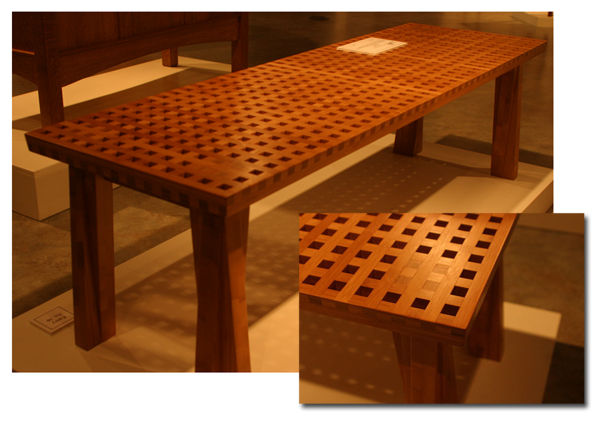
Best in Show went to an understated but flawless bamboo bench by Phillip Sell.
The judges loved its geometrical lines, interesting legs, and clever leg-to-top joinery.
Fine Woodworking gave a special award for craftsmanship to the exquisite
Texas Walnut Writing Desk by Frank Strazza, who is a lead instructor at the
Homestead Heritage School of Woodworking, near Waco.
Strazza harvested and dried the spectacular figured walnut used in the piece.
By the way, we stopped at Rudy’s “Country Store” and Bar-B-Q on the way back to the airport. When we heard their claim–“The Worst Barbecue in Texas”–we had to stop. The brisket is slow-cooked over an oak fire, and you eat on a sheet of waxed paper. The sauce alone is worth the visit. But Rudy’s might be most famous for its unique version of creamed corn, a thick, creamy piece of heaven that my fellow judge, Michael Fortune, and I agreed might be the best side dish we’d ever tasted.
–Asa Christiana

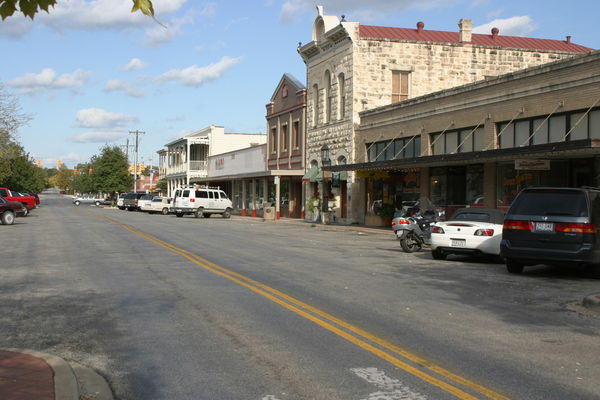

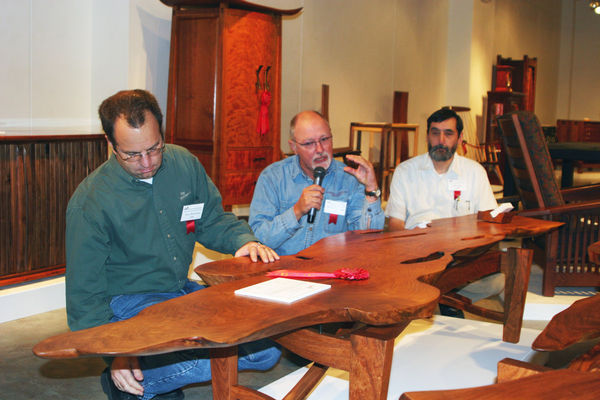
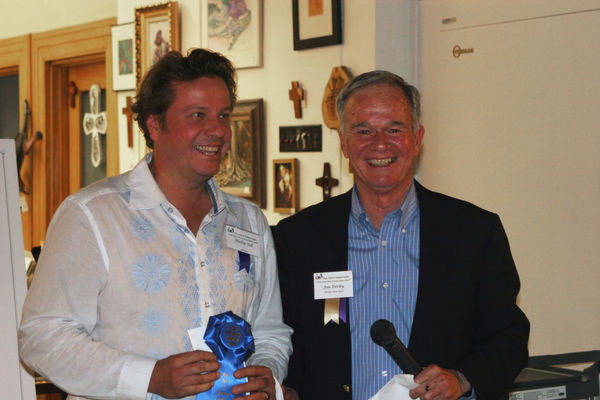
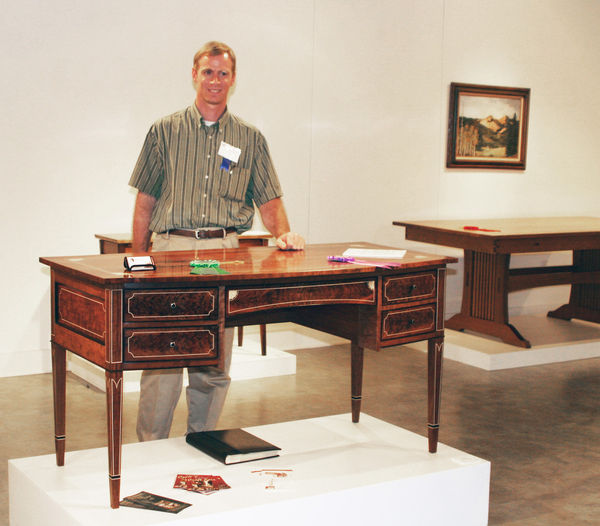


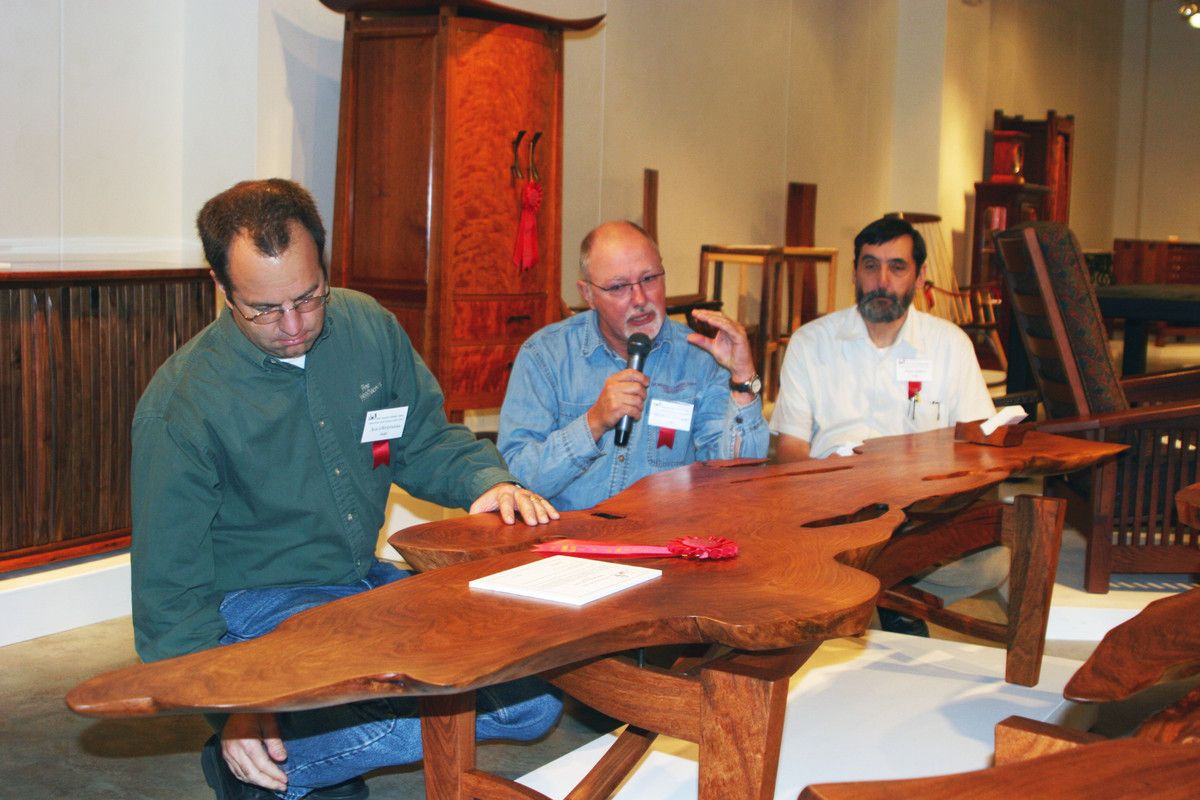
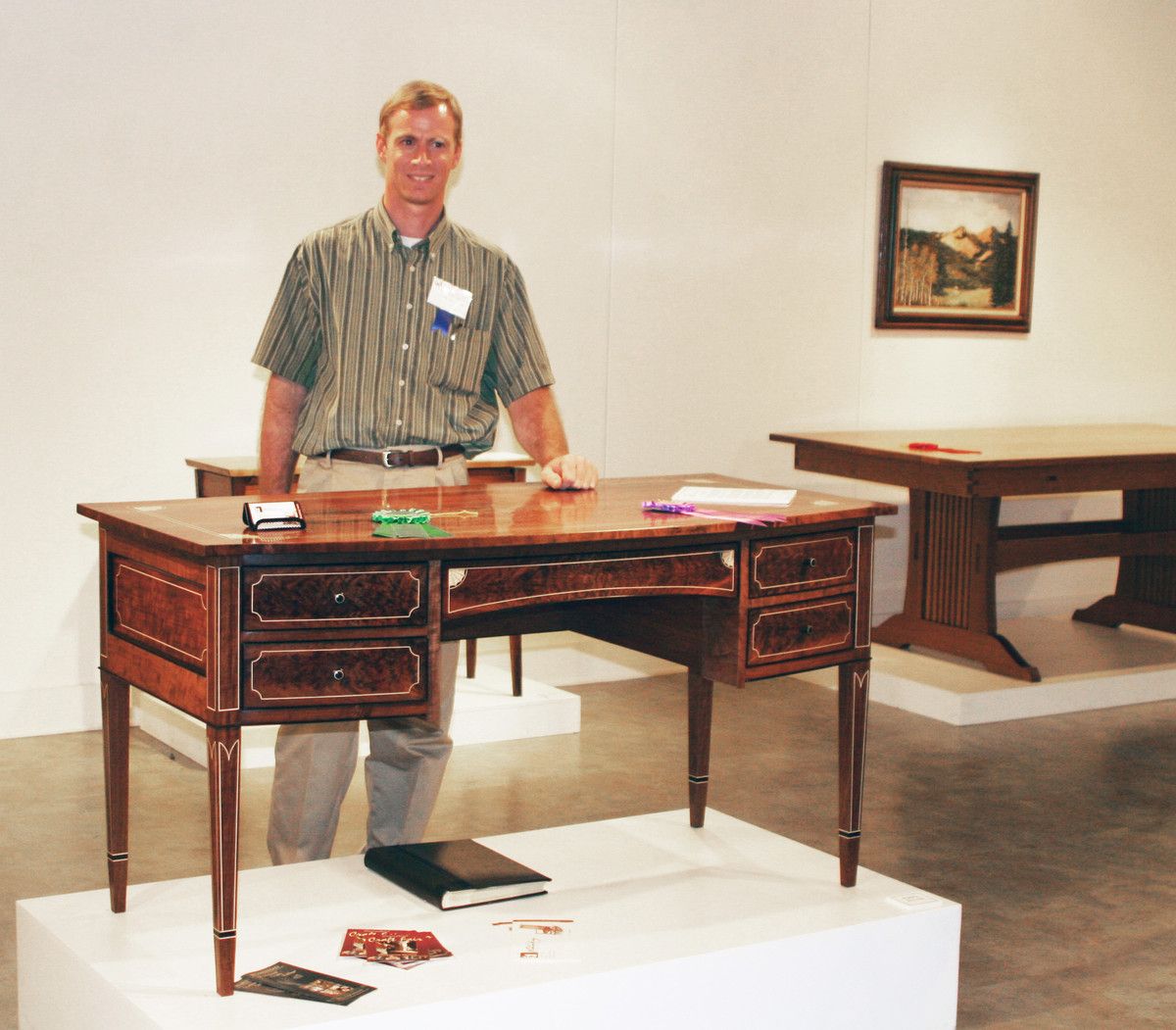

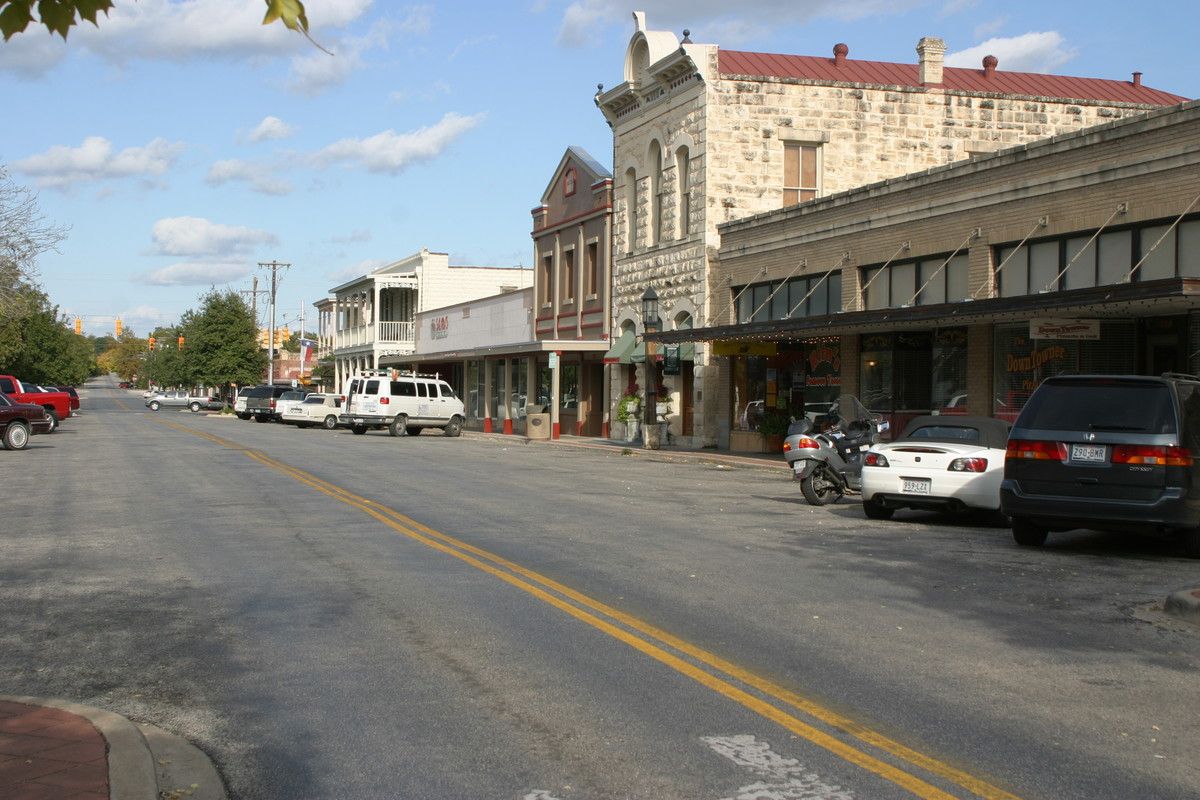





















Comments
I just went to this exhibition this weekend, and I wanted to add what I came away with. It was a pretty eye-opening day...
Although I knew which pieces had won prizes before I went, it would have been pretty easy to see which ones were prize-worthy. The vast majority of these pieces of furniture had gone about 90% of the way, but then fell short in some painfully obvious way.
- The biggest problem was when it came to finishing. Some really excellent furniture had what was obviously the standard can of semi-gloss polyurethane, carefully applied but then left alone, leaving the thick plastic look that was even worse on open-pored woods like mahogany. Or a dining table said to be finished with Waterlox had big patches where the finish looked dulled or damaged.
-I saw lots of tables where there were gaps at the mortise & tenon joint at the leg & apron.
-I saw more than one case where (what should have been) a floating panel had a huge split down the middle of it, perhaps siezed during contraction from the drying winter weather?
-A long flat curved arm of a beatiful rocking chair still had the telltale bumps and ridges from when it was cut on a bandsaw but subsequently not quite smoothed enough - I would have guessed it was only done with a sander...
Part of exhibiting furniture at the show meant that each piece was for sale and had to have a price on it. Of the 60+ pieces that had been sitting there for sale for the last month, only 3 had been sold.
Maybe I'll submit a piece for this show someday. I'll admit I'm still not good enough. But when I do, I'll make sure I get all my details right.
It is easy to find flaws in any group of 60 pieces, and the Kerrville show is no different. But I'd rather talk about what is right about handmade pieces. After all, someone had a picture of something beautiful in their mind's eye, took a pile of rough lumber, and made it happen. And if they made it 90 percent of the way, that is something to celebrate. Also, remember that with a show like this, people are usually rushing to make the deadline. And finishes are usually what suffers. So I always cut people some slack on that. I saw one beautiful inlaid table that had lengthwise ripples sanded into its surface, telltale marks from a poorly set up wide-belt sander. I had a chance to meet the table's maker, and sure enough, he said he had been rushing to get the table to the show, and put it through the big industrial sander to try to quickly get the marquetry level and ready for finish.
Log in or create an account to post a comment.
Sign up Log in